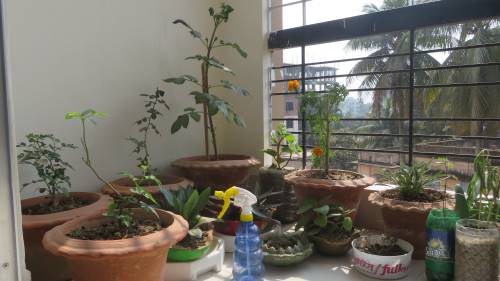
FAQ About Indoor Moss and Algae Control

What are common causes of indoor moss and algae growth?
Common causes of indoor moss and algae growth include high humidity levels, poor air circulation, and excessive moisture in the growing medium or environment. These conditions create an ideal environment for moss and algae to thrive. Lack of adequate light or overwatering can further exacerbate these issues, promoting unwanted growth.

Why is it important to control moss and algae in indoor plant settings?
It is important to control moss and algae in indoor plant settings because their presence can lead to a series of problems including nutrient competition, poor air circulation around plants, and increased risk of fungal infections. Moss and algae can deprive plants of essential growth conditions by consuming resources meant for the plants themselves and can retain excess moisture, leading to root rot and other issues.

How can I prevent algae from forming in my indoor plant pots?
To prevent algae from forming in indoor plant pots, ensure adequate air circulation and avoid overwatering. Use well-draining soil and pots with drainage holes to prevent waterlogging. Providing sufficient light can also help, as algae tend to grow in darker, moist environments. Additionally, cleaning your pots regularly can reduce the presence of algae-promoting spores.

What are natural methods for controlling moss indoors?
Natural methods for controlling moss indoors include managing humidity levels by using dehumidifiers or air conditioners, ensuring proper air circulation with fans, and adjusting watering schedules to reduce moisture. Regularly checking for and promptly removing small amounts of moss can prevent further spreading. You can also use household items like diluted bleach solutions to clean affected areas, being careful to protect your plants.

Can indoor algae be harmful to my plants?
Yes, indoor algae can be harmful to plants. Algae compete for the same nutrients and water that plants need, which can stunt plant growth and lead to deficiencies. Furthermore, algae on soil surfaces can hinder oxygen exchange, affecting root health. It might also promote the growth of fungi and invite pests, which can further harm your plants.

Are there specific plants that are more susceptible to indoor moss and algae?
Certain plants that thrive in high humidity or are typically overwatered are more susceptible to indoor moss and algae. These include tropical plants like ferns and orchids. The conditions required to grow these plants—such as low light and high moisture—also tend to encourage moss and algae growth, necessitating more careful monitoring and control methods.

How can I safely remove algae from my indoor plants without damaging them?
To safely remove algae from indoor plants, gently scrape off any surface algae with a soft brush or cloth. Ensure you remove any excess water or debris surrounding the plant. You can also use a mild soapy water solution to clean algae from leaves and stems, taking care to rinse thoroughly with clean water afterwards. Avoid harsh chemicals that can damage the plant.

What role does light play in controlling indoor moss and algae?
Light plays a significant role in controlling indoor moss and algae. Both moss and algae thrive in low light conditions. By increasing light exposure—either through natural sunlight or grow lights—you can inhibit their growth. Position your plants in well-lit areas and, if necessary, supplement with artificial light to maintain adequate levels of brightness and reduce humidity, which helps deter moss and algae.

Is it necessary to change my watering habits to manage indoor moss and algae?
Yes, adjusting your watering habits is often necessary to manage indoor moss and algae. Overwatering is a common cause of these issues, as it increases the moisture available for them to thrive. By watering plants only when the soil is dry and ensuring proper drainage, you can significantly reduce the chances of moss and algae developing.

Can using specific types of potting soil help prevent moss and algae growth?
Yes, using specific types of potting soil can help in preventing moss and algae growth. Well-draining potting mixes with components like perlite or sand improve aeration and prevent water retention, reducing moisture levels that algae and moss need to grow. Avoid soils that retain too much water or compact easily, as they can create conditions favorable for unwanted growth.

What are some signs that my indoor plants have an algae problem?
Signs that your indoor plants have an algae problem include a green or slimy layer on the soil surface or on the pot, stunted plant growth, and a musty smell. You may also notice yellowing leaves or increased pest activity around plants, which can be indirect effects of algae infesting the growth medium.

Are there commercial products available for controlling indoor moss and algae?
Yes, there are commercial products available specifically designed to control indoor moss and algae. These include algaecides and fungicides that you can apply to your plant soil and surfaces. However, it's important to read product labels carefully for application instructions and safety warnings, ensuring they are safe for use around indoor plants and pets.

How does humidity contribute to moss and algae growth indoors?
Humidity contributes significantly to moss and algae growth as both thrive in moist environments. High humidity levels can create a damp atmosphere where mold spores, including those of moss and algae, can take hold and flourish. Reducing humidity through ventilation, dehumidifiers, or limiting water sources can help control their growth indoors.

What maintenance routines help in preventing indoor moss and algae?
Maintenance routines that help prevent indoor moss and algae include regular cleaning of plant pots and surfaces to remove spores, ensuring good ventilation and airflow, and adjusting watering schedules to avoid excess moisture. It also helps to keep plants trimmed and provide adequate lighting to reduce high humidity environments that support unwanted growth.

Can algae in water-based plant systems like terrariums be managed effectively?
Yes, algae in water-based plant systems like terrariums can be managed effectively by controlling light levels, reducing nutrient concentrations, and cleaning regularly. Consider using distilled or dechlorinated water to fill your terrarium and ensuring any decomposing plant matter is removed promptly to reduce nutrient buildup that fosters algae growth.

Why do closed terrariums often face moss and algae problems?
Closed terrariums often face moss and algae problems due to their self-contained, humid environments which create ideal conditions for these organisms to thrive. Without proper light management and ventilation, humidity levels can remain high, promoting the rapid growth of moss and algae alongside the plants.

What are some DIY solutions for controlling moss and algae in plant pots?
DIY solutions for controlling moss and algae in plant pots include applying a mix of diluted white vinegar or hydrogen peroxide to the affected areas, being careful not to touch the plant roots. Regular cleaning of pots and plant bases with these solutions can kill algae without harming the plant itself. Another option is using cinnamon, a natural antifungal agent, sprinkled lightly on the soil surface to prevent growth.

Can algae growth indicate other issues in my indoor gardening setup?
Yes, algae growth can indicate other issues in your indoor gardening setup, such as overwatering, poor lighting, or inadequate ventilation. Since algae flourish under these conditions, their presence might suggest you need to adjust some environmental factors to better suit your plants' needs while preventing further issues.

How can improving air circulation help in controlling indoor moss and algae?
Improving air circulation helps in controlling indoor moss and algae by reducing the stagnant, warm, and moist conditions they prefer. Using fans or opening windows can increase airflow, helping to dry surface moisture quickly and reducing the humidity levels that encourage moss and algae proliferation.

Are there any plants that naturally help reduce moss and algae growth indoors?
While no plants directly reduce moss and algae growth, selecting indoor plants that require less humidity and water can indirectly help by not creating conditions ideal for moss and algae. Succulents and cacti, for example, require dry environments and contribute to maintaining lower humidity levels indoors, thereby helping to reduce moss and algae problems.
